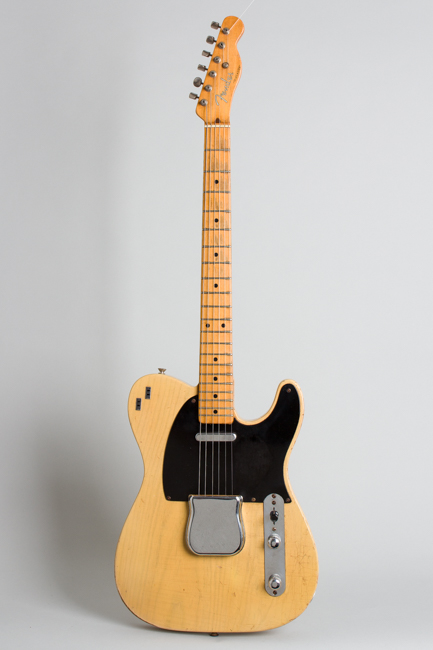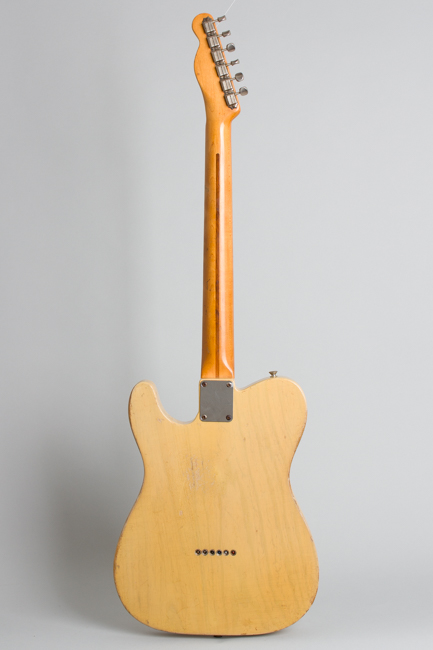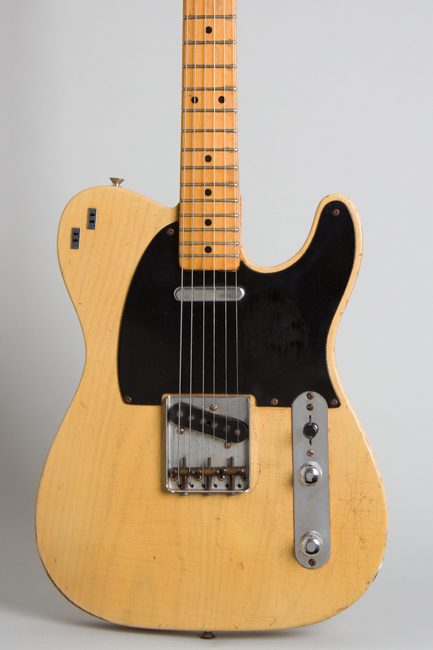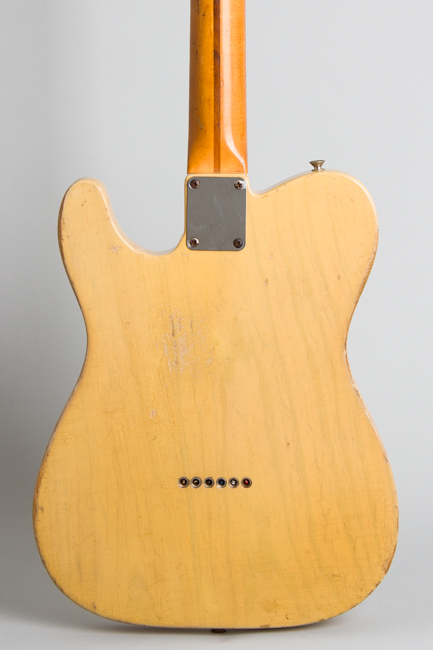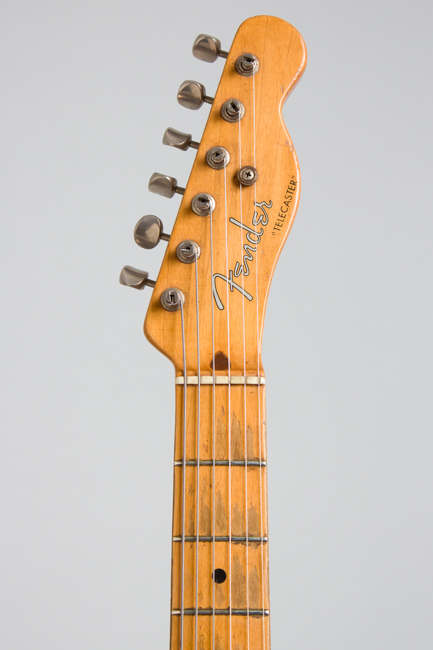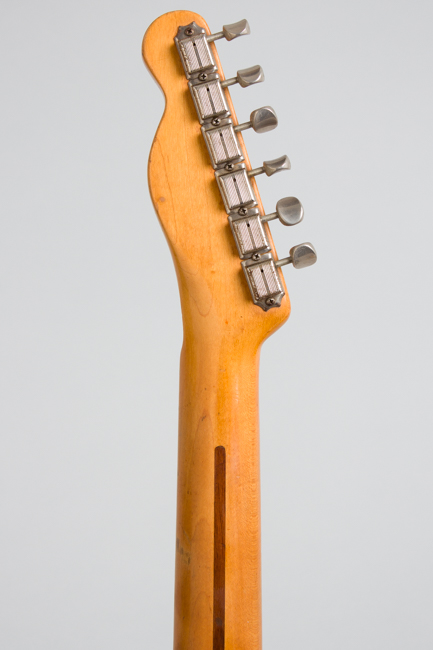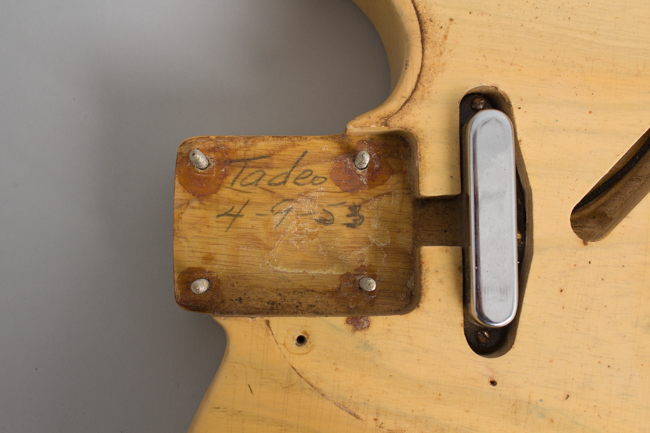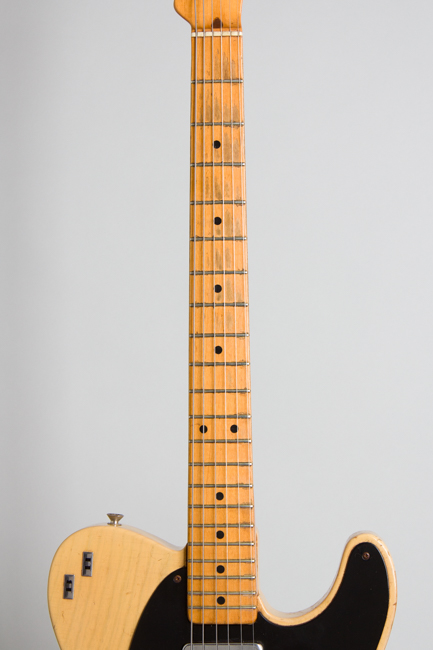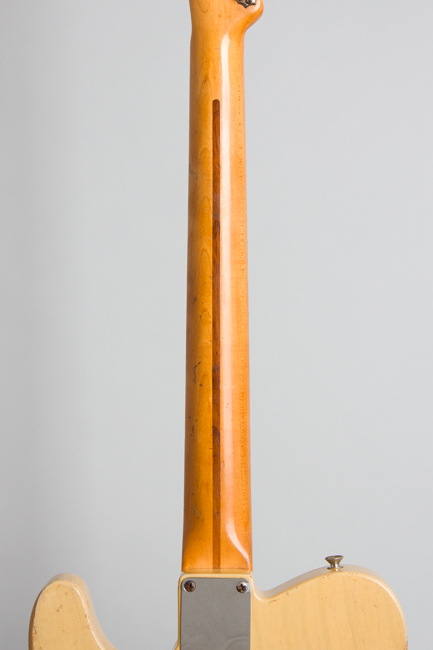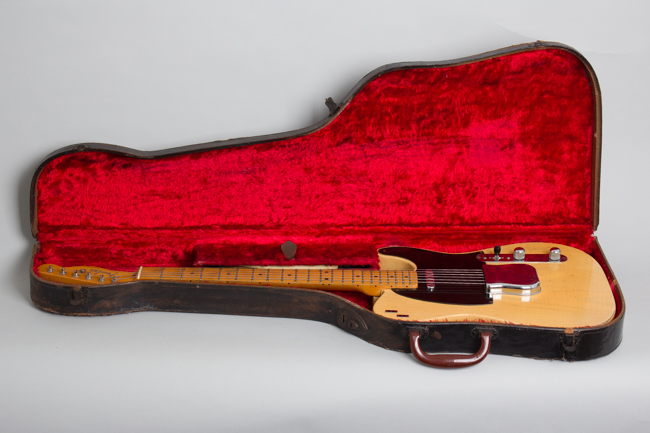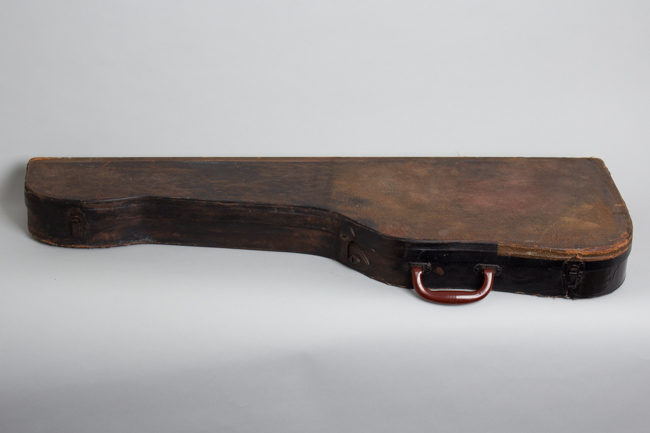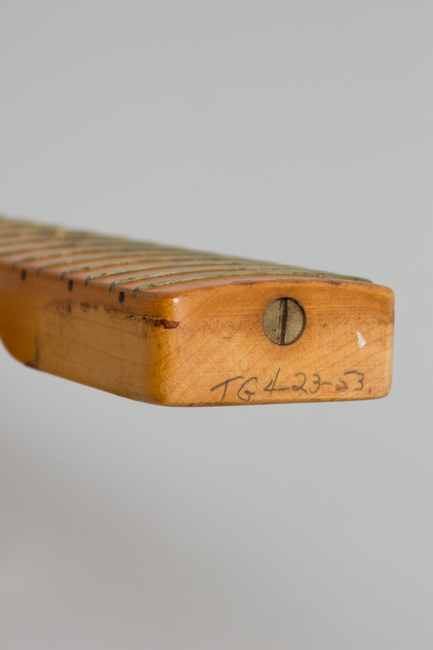Fender Telecaster Solid Body Electric Guitar (1953)
This item has been sold.
Item # 12825
Prices subject to change without notice.
Fender Telecaster Model Solid Body Electric Guitar (1953), made in Fullerton, California, serial # 3168, blonde lacquer finish, ash body, maple neck, original brown hard shell case.
This is a played-in but still beautiful example of a "Blackguard" Telecaster -- the guitar that put Leo Fender's company on the map for all time. It was built just as the company was about to move from their original cinder-block factory in Fullerton, California in the summer of 1953 and retains all the classic '52 features. The one-piece maple neck, aged "butterscotch" blonde-finished ash body, lacquered black fiber pickguard, brass bridge saddles, and of course the original black-bobbin hand wound pickups with a sound for the ages are all present and accounted for.
This guitar carries serial number 3168 stamped into the bridgeplate, with a neck marking TG 4-23-53 in pencil on the heel. The body carries a date mark of 4-9-53 in the neck pocket, with "Tadeo" (for Fender craftsman Tadeo Gomez) written above it. The masking tape note in the control cavity indicates the guitar was wired up by Gloria on April 28th of '53; these dates are more closely grouped than many early Fenders. Perhaps Fender sales had a run of orders in spring '53 the factory was pushing to complete! One of the pot date codes is legible reading 220 designating the 20th week of 1952; the other appears to match but is partially soldered over.
This guitar has been played but not abused since it was shipped out in mid 1953. All parts remain original including the early wiring rig; unlike many, it has never been re-wired to the "modern" Telecaster switching scheme. As originally set up there is a "deep bass" capacitor on the neck pickup in switch position #1; position #2 is the neck pickup in normal mode, and #3 is the bridge pickup with a master tone control. The neck and bridge pickups can be combined by carefully lodging the selector between positions #2 and #3, which on this guitar is noticeably out-of-phase. As they were never meant to be heard combined this was not considered an issue at the time.
The very comfortable neck has a very comfortable profile, round-backed but with more dress-away and less of a rounded "C throat" in the lower positions than some '53s we have had. The screws are mostly Phillips-head as is customary for 1953; the truss rod is still a single slot, rare but not unknown in earlier '53 as older stock parts were used up. The bridge does not have its brass saddles notched under the outside ends, as was done later in '53. At just over 7 1/2 Lbs.
(with the bridge cover on) this is still a fairly light and handy guitar if not featherweight.
For many, this is one of the two classic Telecaster years, with the same look and feel of the earliest Fender Broadcaster and "No-Caster" guitars from 1950-51, but more consistent production standards. Before the introduction of the Stratocaster in 1954, the Tele and Precision Bass were already causing a revolution in playing styles and shaking up the electric guitar world in a big way. The Telecaster was totally unique in look, feel, and sound, and became instantly popular, particularly with country players. In the years since, many players and collectors have come to consider the 1950-54 Telecaster the finest electric guitar ever made -- and one of the most historically important as well.
In his authoritative and beautiful book "The Blackguard", author Nacho Banos calls '53 "The year Fender got it nailed...Collectors and players alike consider 1953 a cornerstone year for the Blackguard. Some of the most legendary artists associated with Telecasters have used guitars manufactured during this pivotal year. Red Volkaert, Roy Buchanan, Danny Gatton, early James Burton, Keith Richards, Albert Lee, Arlen Roth and Countless others". Early Fender Telecasters of this period are universally considered as one of the most collectible and historic of all electric guitars, and this is a lovely original example.
Overall length is 38 3/4 in. (98.4 cm.), 12 3/4 in. (32.4 cm.) wide at lower bout, and 1 3/4 in. (4.4 cm.) in depth, measured at side of rim. Scale length is 25 1/2 in. (648 mm.). Width of nut is 1 5/8 in. (41 mm.)., 7.69 lbs.
Overall this is a very nice example of a "summer '53 Blackguard" showing some typical wear and tear but no notable work or alteration except what appears to be an ancient correct-wire refret. All components remain original, including the factory the "mud cap" wiring.
The all-original thin lacquer body finish has not ambered as much as many and has checked somewhat unevenly. The guitar shows typical dings, dents, and worn spots, especially to the lower edge as usual, but no large areas of loss except one noticeable scratched-up belt buckle spot on the center/lower back. There are a couple of fairly small case lid dings on the top behind the bridge. The original owner added mailbox letters "BH" to the upper top; his name was B. Hackleman and there is a nice letter from his nephew confirming this was a one-family guitar until it was first resold in 2017.
The finish on the back of the neck is smoothly worn down to the wood over much of its length mostly on the treble side, with a few scattered dings and dents. The fingerboard has a number of wear spots through the lacquer running up the board. There is no detectable finish work or overspray. The guitar has original style small frets, there is some chipping to the fingerboard lacquer which leads us to believe it may have been refretted long ago, but the wire appears correct Fender stock. These frets show some noticeable wear and recrowning; they are still playable but if the guitar is to be heavily used a refret might be in order for some players; this can be arranged as part of the purchase. The bone nut appears original.
All hardware on the instrument is original. The pickguard has some wear through the lacquer in the usual area below the strings (and some light scratching above them) from play. The bridge saddles and have some typical corrosion and discoloration but nothing is rusted hard and all adjustment screws are functional. The original "ashtray" bridge cover is present, along with a period strap and polish cloth.
Other than the possible ancient refret this instrument remains pretty much as it left Fullerton in spring/summer 1953, with less wear from years of hard gigging behind it than many of these now show and none of the drastic modifications that befell way too many. Wherever it has been, this is a truly fantastic-sounding guitar, with a powerful bridge pickup that really rips or twangs sweetly as required and a nice mellow neck pickup. The guitar is still housed in the original shaped, flat-bottom hard case, a major rarity in itself that was painted black long ago (somewhat worn through now) and has some general wear but is still solid. This is the nicest '53 Tele we have had in a while, a splendid twang machine and serious piece of Fender -- and guitar -- history. It includes a book of photos of the guitar and the letter from the original owner's nephew detailing the provenance. Overall Excellent - Condition.
This is a played-in but still beautiful example of a "Blackguard" Telecaster -- the guitar that put Leo Fender's company on the map for all time. It was built just as the company was about to move from their original cinder-block factory in Fullerton, California in the summer of 1953 and retains all the classic '52 features. The one-piece maple neck, aged "butterscotch" blonde-finished ash body, lacquered black fiber pickguard, brass bridge saddles, and of course the original black-bobbin hand wound pickups with a sound for the ages are all present and accounted for.
This guitar carries serial number 3168 stamped into the bridgeplate, with a neck marking TG 4-23-53 in pencil on the heel. The body carries a date mark of 4-9-53 in the neck pocket, with "Tadeo" (for Fender craftsman Tadeo Gomez) written above it. The masking tape note in the control cavity indicates the guitar was wired up by Gloria on April 28th of '53; these dates are more closely grouped than many early Fenders. Perhaps Fender sales had a run of orders in spring '53 the factory was pushing to complete! One of the pot date codes is legible reading 220 designating the 20th week of 1952; the other appears to match but is partially soldered over.
This guitar has been played but not abused since it was shipped out in mid 1953. All parts remain original including the early wiring rig; unlike many, it has never been re-wired to the "modern" Telecaster switching scheme. As originally set up there is a "deep bass" capacitor on the neck pickup in switch position #1; position #2 is the neck pickup in normal mode, and #3 is the bridge pickup with a master tone control. The neck and bridge pickups can be combined by carefully lodging the selector between positions #2 and #3, which on this guitar is noticeably out-of-phase. As they were never meant to be heard combined this was not considered an issue at the time.
The very comfortable neck has a very comfortable profile, round-backed but with more dress-away and less of a rounded "C throat" in the lower positions than some '53s we have had. The screws are mostly Phillips-head as is customary for 1953; the truss rod is still a single slot, rare but not unknown in earlier '53 as older stock parts were used up. The bridge does not have its brass saddles notched under the outside ends, as was done later in '53. At just over 7 1/2 Lbs.
(with the bridge cover on) this is still a fairly light and handy guitar if not featherweight.
For many, this is one of the two classic Telecaster years, with the same look and feel of the earliest Fender Broadcaster and "No-Caster" guitars from 1950-51, but more consistent production standards. Before the introduction of the Stratocaster in 1954, the Tele and Precision Bass were already causing a revolution in playing styles and shaking up the electric guitar world in a big way. The Telecaster was totally unique in look, feel, and sound, and became instantly popular, particularly with country players. In the years since, many players and collectors have come to consider the 1950-54 Telecaster the finest electric guitar ever made -- and one of the most historically important as well.
In his authoritative and beautiful book "The Blackguard", author Nacho Banos calls '53 "The year Fender got it nailed...Collectors and players alike consider 1953 a cornerstone year for the Blackguard. Some of the most legendary artists associated with Telecasters have used guitars manufactured during this pivotal year. Red Volkaert, Roy Buchanan, Danny Gatton, early James Burton, Keith Richards, Albert Lee, Arlen Roth and Countless others". Early Fender Telecasters of this period are universally considered as one of the most collectible and historic of all electric guitars, and this is a lovely original example.
Overall length is 38 3/4 in. (98.4 cm.), 12 3/4 in. (32.4 cm.) wide at lower bout, and 1 3/4 in. (4.4 cm.) in depth, measured at side of rim. Scale length is 25 1/2 in. (648 mm.). Width of nut is 1 5/8 in. (41 mm.)., 7.69 lbs.
Overall this is a very nice example of a "summer '53 Blackguard" showing some typical wear and tear but no notable work or alteration except what appears to be an ancient correct-wire refret. All components remain original, including the factory the "mud cap" wiring.
The all-original thin lacquer body finish has not ambered as much as many and has checked somewhat unevenly. The guitar shows typical dings, dents, and worn spots, especially to the lower edge as usual, but no large areas of loss except one noticeable scratched-up belt buckle spot on the center/lower back. There are a couple of fairly small case lid dings on the top behind the bridge. The original owner added mailbox letters "BH" to the upper top; his name was B. Hackleman and there is a nice letter from his nephew confirming this was a one-family guitar until it was first resold in 2017.
The finish on the back of the neck is smoothly worn down to the wood over much of its length mostly on the treble side, with a few scattered dings and dents. The fingerboard has a number of wear spots through the lacquer running up the board. There is no detectable finish work or overspray. The guitar has original style small frets, there is some chipping to the fingerboard lacquer which leads us to believe it may have been refretted long ago, but the wire appears correct Fender stock. These frets show some noticeable wear and recrowning; they are still playable but if the guitar is to be heavily used a refret might be in order for some players; this can be arranged as part of the purchase. The bone nut appears original.
All hardware on the instrument is original. The pickguard has some wear through the lacquer in the usual area below the strings (and some light scratching above them) from play. The bridge saddles and have some typical corrosion and discoloration but nothing is rusted hard and all adjustment screws are functional. The original "ashtray" bridge cover is present, along with a period strap and polish cloth.
Other than the possible ancient refret this instrument remains pretty much as it left Fullerton in spring/summer 1953, with less wear from years of hard gigging behind it than many of these now show and none of the drastic modifications that befell way too many. Wherever it has been, this is a truly fantastic-sounding guitar, with a powerful bridge pickup that really rips or twangs sweetly as required and a nice mellow neck pickup. The guitar is still housed in the original shaped, flat-bottom hard case, a major rarity in itself that was painted black long ago (somewhat worn through now) and has some general wear but is still solid. This is the nicest '53 Tele we have had in a while, a splendid twang machine and serious piece of Fender -- and guitar -- history. It includes a book of photos of the guitar and the letter from the original owner's nephew detailing the provenance. Overall Excellent - Condition.
